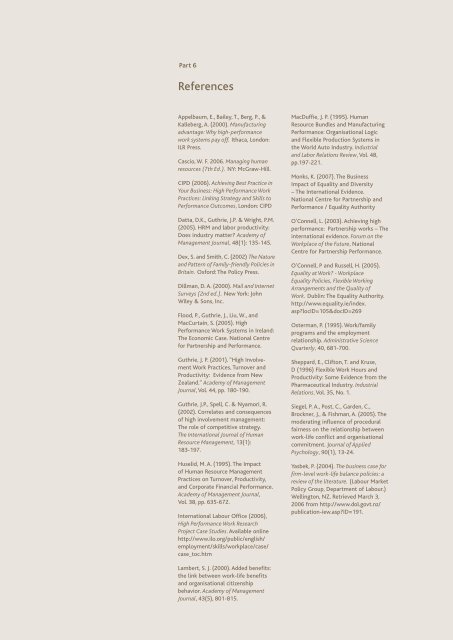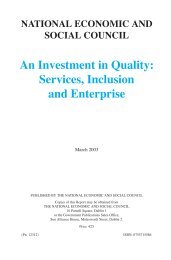New Models of High Performance Work Systems - Equality Authority
New Models of High Performance Work Systems - Equality Authority
New Models of High Performance Work Systems - Equality Authority
You also want an ePaper? Increase the reach of your titles
YUMPU automatically turns print PDFs into web optimized ePapers that Google loves.
this is the section name<br />
Part 6<br />
References<br />
Appelbaum, E., Bailey, T., Berg, P., &<br />
Kalleberg, A. (2000). Manufacturing<br />
advantage: Why high-performance<br />
work systems pay <strong>of</strong>f. Ithaca, London:<br />
ILR Press.<br />
Cascio, W. F. 2006. Managing human<br />
resources (7th Ed.). NY: McGraw-Hill.<br />
CIPD (2006). Achieving Best Practice in<br />
Your Business: <strong>High</strong> <strong>Performance</strong> <strong>Work</strong><br />
Practices: Linking Strategy and Skills to<br />
<strong>Performance</strong> Outcomes, London: CIPD<br />
Datta, D.K., Guthrie, J.P. & Wright, P.M.<br />
(2005). HRM and labor productivity:<br />
Does industry matter Academy <strong>of</strong><br />
Management Journal, 48(1): 135-145.<br />
Dex, S. and Smith, C. (2002) The Nature<br />
and Pattern <strong>of</strong> Family-friendly Policies in<br />
Britain. Oxford: The Policy Press.<br />
Dillman, D. A. (2000). Mail and Internet<br />
Surveys (2nd ed.). <strong>New</strong> York: John<br />
Wiley & Sons, Inc.<br />
Flood, P., Guthrie, J., Liu, W., and<br />
MacCurtain, S. (2005). <strong>High</strong><br />
<strong>Performance</strong> <strong>Work</strong> <strong>Systems</strong> in Ireland:<br />
The Economic Case. National Centre<br />
for Partnership and <strong>Performance</strong>.<br />
Guthrie, J. P. (2001). “<strong>High</strong> Involvement<br />
<strong>Work</strong> Practices, Turnover and<br />
Productivity: Evidence from <strong>New</strong><br />
Zealand.” Academy <strong>of</strong> Management<br />
Journal, Vol. 44, pp. 180-190.<br />
Guthrie, J.P., Spell, C. & Nyamori, R.<br />
(2002). Correlates and consequences<br />
<strong>of</strong> high involvement management:<br />
The role <strong>of</strong> competitive strategy.<br />
The International Journal <strong>of</strong> Human<br />
Resource Management, 13(1):<br />
183-197.<br />
Huselid, M. A. (1995). The Impact<br />
<strong>of</strong> Human Resource Management<br />
Practices on Turnover, Productivity,<br />
and Corporate Financial <strong>Performance</strong>.<br />
Academy <strong>of</strong> Management Journal,<br />
Vol. 38, pp. 635-672.<br />
International Labour Office (2006),<br />
<strong>High</strong> <strong>Performance</strong> <strong>Work</strong> Research<br />
Project Case Studies. Available online<br />
http://www.ilo.org/public/english/<br />
employment/skills/workplace/case/<br />
case_toc.htm<br />
Lambert, S. J. (2000). Added benefits:<br />
the link between work-life benefits<br />
and organisational citizenship<br />
behavior. Academy <strong>of</strong> Management<br />
Journal, 43(5), 801-815.<br />
MacDuffie, J. P. (1995). Human<br />
Resource Bundles and Manufacturing<br />
<strong>Performance</strong>: Organisational Logic<br />
and Flexible Production <strong>Systems</strong> in<br />
the World Auto Industry. Industrial<br />
and Labor Relations Review, Vol. 48,<br />
pp.197-221.<br />
Monks, K. (2007). The Business<br />
Impact <strong>of</strong> <strong>Equality</strong> and Diversity<br />
– The International Evidence.<br />
National Centre for Partnership and<br />
<strong>Performance</strong> / <strong>Equality</strong> <strong>Authority</strong><br />
O’Connell, L. (2003). Achieving high<br />
performance: Partnership works – The<br />
international evidence. Forum on the<br />
<strong>Work</strong>place <strong>of</strong> the Future, National<br />
Centre for Partnership <strong>Performance</strong>.<br />
O’Connell, P and Russell, H. (2005).<br />
<strong>Equality</strong> at <strong>Work</strong> - <strong>Work</strong>place<br />
<strong>Equality</strong> Policies, Flexible <strong>Work</strong>ing<br />
Arrangements and the Quality <strong>of</strong><br />
<strong>Work</strong>. Dublin: The <strong>Equality</strong> <strong>Authority</strong>.<br />
http://www.equality.ie/index.<br />
asplocID=105&docID=269<br />
Osterman, P. (1995). <strong>Work</strong>/family<br />
programs and the employment<br />
relationship. Administrative Science<br />
Quarterly, 40, 681-700.<br />
Sheppard, E., Clifton, T. and Kruse,<br />
D (1996) Flexible <strong>Work</strong> Hours and<br />
Productivity: Some Evidence from the<br />
Pharmaceutical Industry. Industrial<br />
Relations, Vol. 35, No. 1.<br />
Siegel, P. A., Post, C., Garden, C.,<br />
Brockner, J., & Fishman, A. (2005). The<br />
moderating influence <strong>of</strong> procedural<br />
fairness on the relationship between<br />
work-life conflict and organisational<br />
commitment. Journal <strong>of</strong> Applied<br />
Psychology, 90(1), 13-24.<br />
Yasbek, P. (2004). The business case for<br />
firm-level work-life balance policies: a<br />
review <strong>of</strong> the literature. (Labour Market<br />
Policy Group, Department <strong>of</strong> Labour.)<br />
Wellington, NZ. Retrieved March 3,<br />
2006 from http://www.dol.govt.nz/<br />
publication-iew.aspID=191.<br />
< 47
















